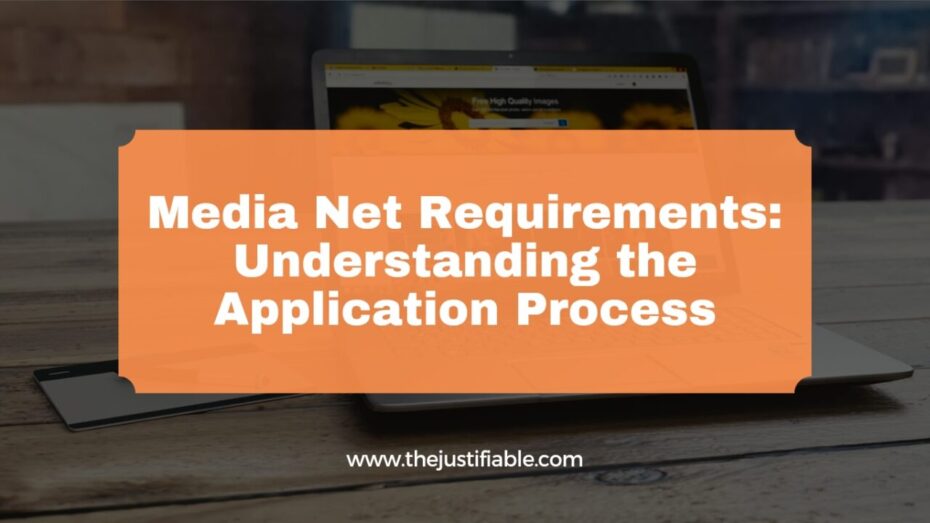Table of Contents
This in-depth guide will cover all the essential aspects of Media net requirements, including publisher approval criteria, eligibility criteria, minimum traffic requirements, application process, content quality guidelines, ad placement rules, supported niches, monetization requirements, and much more.
Our goal is to provide you with a comprehensive understanding of the Media.net platform and its requirements, ensuring that you have all the necessary information to make an informed decision and effectively navigate the application process.
Brief Overview
Media.net is a highly reputable contextual advertising platform that has gained significant recognition for its ability to deliver highly relevant and targeted ads to publishers and advertisers worldwide. Founded in 2010, Media net is powered by the Yahoo! Bing Network, offering a wide range of ad formats and sizes to cater to various content niches and audience preferences.
As an alternative to Google Adsense, Media.net has successfully carved out its own space in the digital advertising industry, known for its user-friendly interface, transparent reporting, and dedicated account management support. The platform’s primary focus is on contextual advertising, which entails displaying ads based on the content and context of a publisher’s website.
This approach ensures that the ads displayed on a website are relevant to the users’ interests, resulting in higher click-through rates (CTRs) and improved user experience. Media.net’s proprietary ad-serving technology also incorporates machine learning algorithms and real-time bidding, allowing publishers to optimize ad placements and maximize revenue potential.
Importance of Understanding Media net Requirements
Understanding Media net requirements is of paramount importance for publishers seeking to leverage the platform’s potential and gain approval for their websites. Comprehending the criteria set forth by Media.net ensures that publishers can make the necessary adjustments to their websites to meet the platform’s standards, which in turn increases the likelihood of approval and long-term success.
Adhering to the Media net requirements also has numerous benefits beyond simply gaining approval. For one, compliance with the platform’s content quality guidelines and ad placement rules ensures that the ads displayed on a publisher’s website will provide value to users and enhance the overall user experience.
Furthermore, by understanding and fulfilling the platform’s minimum traffic requirements, publishers can maximize their revenue potential and benefit from a wider range of advertising opportunities. In addition to these advantages, complying with Media net requirements can also help protect a publisher’s account from suspension or termination due to policy violations.
By staying up-to-date with the platform’s guidelines and making adjustments as needed, publishers can maintain a positive relationship with Media.net and continue to capitalize on the platform’s revenue-generating capabilities.
Requirements for Publishers
In order to achieve success and maintain a fruitful partnership with Media.net, publishers must adhere to the platform’s requirements and guidelines. These requirements are designed to ensure that the ads served by Media.net are relevant, engaging, and beneficial for both publishers and their users.
In this section, we will provide an in-depth exploration of the key Media net requirements for publishers, including publisher approval criteria, eligibility criteria, and minimum traffic requirements.
Publisher Approval Criteria
Media.net is committed to maintaining a high-quality advertising network, which is why it has stringent publisher approval criteria in place. These criteria help to ensure that only websites that meet the platform’s standards are granted access to its advertising opportunities. The following are the key publisher approval criteria that Media.net considers during the application process:
- Content Quality: Publishers must have unique, high-quality, and engaging content that provides value to users. Websites with plagiarized, poorly written, or thin content will not be approved.
- Language: Websites must be primarily in English, as Media.net’s ad inventory caters predominantly to English-speaking audiences.
- Site Design: Publishers must maintain a professional and user-friendly website design, with easy navigation and a clean layout.
- Traffic: Media.net requires publishers to have a minimum amount of traffic to ensure that their ads will reach a sizable audience. Although no specific numbers are provided, websites with higher traffic from countries like the US, UK, and Canada are more likely to be approved.
- Legal Compliance: Websites must adhere to all applicable laws, regulations, and guidelines, including those related to copyright, privacy, and user data protection.
Media net Eligibility Criteria
In addition to the publisher approval criteria, Media.net has specific eligibility criteria that publishers must meet to join the platform. These criteria are designed to ensure that the network remains high-quality and that the ads displayed are appropriate and relevant. The following are the key eligibility criteria for Media.net:
- Prohibited Content: Websites containing adult, violent, hateful, or illegal content are not eligible to join Media.net.
- Ad Placement: Publishers must ensure that their ad placements do not interfere with the user experience or result in accidental clicks.
- Malware and Deceptive Practices: Websites involved in malware distribution or deceptive practices, such as phishing or cloaking, are not eligible for Media.net.
- Traffic Sources: Media.net does not allow publishers to use artificial means to inflate their website traffic, such as bots or paid traffic services.
Minimum Traffic Requirements
While Media.net does not explicitly state a specific minimum traffic requirement for publishers, having a reasonable amount of organic traffic is essential for approval. Websites with higher traffic volumes, particularly from countries like the US, UK, and Canada, have a better chance of being approved by Media.net.
Publishers should focus on building their audience through quality content, effective SEO strategies, and social media marketing to increase their chances of meeting Media.net’s traffic requirements and gaining approval.
How to Join Media.net
Joining Media.net as a publisher is a straightforward process, but it requires careful attention to the platform’s requirements and guidelines to ensure approval and a successful partnership.
In this section, we will provide an in-depth, step-by-step guide on how to join Media.net, along with essential tips for approval and insights into account suspension reasons.
Application Process
To join Media.net as a publisher, follow the steps outlined below:
- Visit the Media.net website: Navigate to the official Media.net website and click on the “Publisher” tab to access the publisher signup page.
- Complete the signup form: Fill out the signup form with the required information, including your name, email address, website URL, and phone number. Make sure to provide accurate and up-to-date information.
- Accept the terms and conditions: Review and accept Media.net’s terms and conditions to proceed with the application process. Ensure that you understand and agree to comply with the platform’s guidelines.
- Submit your application: Click on the “Submit” button to submit your application for review. Media.net’s approval team will assess your website and determine its eligibility based on the platform’s requirements and criteria.
- Wait for approval: The approval process can take anywhere from a few days to a couple of weeks, depending on the volume of applications. Be patient and wait for Media.net’s team to contact you with their decision.
- Set up your account: If your application is approved, you will receive an email from Media.net with instructions on how to set up your account and start displaying ads on your website.
Media net Approval Tips
To increase your chances of approval, consider the following tips:
- Focus on high-quality content: Ensure that your website features unique, valuable, and engaging content that appeals to your target audience.
- Optimize your website design: Maintain a clean, professional, and user-friendly website design, with easy navigation and an intuitive layout.
- Build organic traffic: Focus on growing your website’s traffic through SEO strategies, social media marketing, and other legitimate methods. Media.net prefers websites with substantial traffic from countries like the US, UK, and Canada.
- Adhere to eligibility criteria: Review and comply with Media.net’s eligibility criteria to avoid disapproval or account suspension.
- Remove conflicting ad networks: Before applying to Media.net, consider removing any ads from competing ad networks, as this may improve your chances of approval.
Account Suspension Reasons
Being aware of the common reasons for account suspension can help you avoid potential pitfalls and maintain a successful partnership with Media.net. Some of the main reasons for account suspension include:
- Policy violations: Failing to comply with Media.net’s guidelines, content quality requirements, or ad placement rules can result in account suspension.
- Invalid traffic: Using artificial means to inflate your website’s traffic, such as bots or paid traffic services, can lead to account suspension.
- Prohibited content: Hosting adult, violent, hateful, or illegal content on your website can result in suspension or termination of your Media.net account.
- Fraudulent activity: Engaging in fraudulent activities, such as click fraud or cookie stuffing, can lead to account suspension.
Media net Website Requirements
To ensure a successful partnership with Media.net and maximize revenue potential, publishers must adhere to the platform’s website requirements. These requirements are designed to promote a high-quality advertising ecosystem and an optimal user experience.
In this section, we will provide an in-depth overview of Media.net’s website requirements, covering content quality guidelines, website compliance, supported niches, and monetization requirements.
Media.net Content Quality Guidelines
Media.net places a strong emphasis on the quality of content published on its partner websites. The following content quality guidelines must be met by publishers to maintain compliance with Media.net’s requirements:
- Unique and original content: Publishers must create original, unique content that offers value to users and avoids plagiarism.
- Well-written and engaging: Content must be well-written, grammatically correct, and engaging for the target audience.
- Updated regularly: Websites should be updated regularly with fresh content to maintain user interest and improve search engine rankings.
- Relevant to the niche: Content must be relevant to the website’s niche and audience, ensuring that ads displayed on the site are contextually appropriate.
Website Compliance
To remain in compliance with Media.net’s requirements, publishers must adhere to the following website standards:
- Professional design: Websites must have a professional, user-friendly design with easy navigation and a clean layout.
- Clear ad placement: Ads should be placed in visible and appropriate locations on the website, without interfering with the user experience or causing accidental clicks.
- Compliance with laws and regulations: Publishers must ensure that their websites adhere to all applicable laws, regulations, and guidelines, including those related to copyright, privacy, and user data protection.
- No prohibited content: Websites containing adult, violent, hateful, or illegal content are not permitted within the Media.net network.
Media net Supported Niches
Media.net supports a wide range of content niches, making it a versatile advertising platform for publishers. Some of the most popular and profitable niches on Media.net include technology, health and wellness, finance, travel, and education.
While the platform is open to various niches, it is essential to ensure that your website’s content aligns with Media.net’s content quality guidelines and compliance standards.
Website Monetization Requirements
To successfully monetize your website with Media.net, adhere to the following requirements:
- Traffic sources: Ensure that your website’s traffic is primarily organic, and avoid using artificial means, such as bots or paid traffic services, to inflate your numbers.
- Ad formats and sizes: Select the appropriate ad formats and sizes for your website, considering both user experience and revenue potential.
- Ad placement optimization: Regularly analyze your ad performance and optimize ad placements to maximize revenue without sacrificing user experience.
- Monitor policy compliance: Continuously monitor your website’s compliance with Media.net’s guidelines and make adjustments as needed to avoid account suspension or termination.
Media net Advertising Guidelines
Media.net’s advertising guidelines are designed to ensure that ads displayed on publisher websites are of high quality, contextually relevant, and non-intrusive to the user experience. Adhering to these guidelines is crucial for publishers who want to maintain a successful partnership with Media.net and maximize their revenue potential.
In this section, we will provide an in-depth overview of Media.net’s advertising guidelines, covering ad placement rules, user experience guidelines, ad formats and sizes, and revenue share percentage.
Media.net Ad Placement Rules
To maintain compliance with Media.net’s guidelines, publishers must follow the ad placement rules outlined below:
- Clear ad labeling: Ads must be clearly labeled as advertisements or sponsored content to avoid confusion and ensure transparency for users.
- Non-intrusive placements: Ads should be placed in a manner that does not obstruct or interfere with the user experience. Avoid placing ads in locations that may result in accidental clicks or excessive scrolling.
- Contextually relevant: Ad placements should be contextually relevant to the content on the page to ensure a positive user experience and higher click-through rates.
- Ad density: Ensure that your website maintains a balanced ad-to-content ratio, avoiding excessive ad placements that may negatively impact the user experience.
User Experience Guidelines
Media.net emphasizes the importance of user experience and expects its publishers to adhere to the following guidelines:
- User-friendly navigation: Websites should have a clean, intuitive layout with easy navigation, allowing users to find and access content effortlessly.
- Fast loading times: Publishers must optimize their websites for fast loading times, as slow-loading pages can negatively impact the user experience and ad performance.
- Mobile optimization: Websites should be optimized for mobile devices, ensuring a seamless user experience across different screen sizes and devices.
- Minimal pop-ups and overlays: Avoid using excessive pop-ups or overlays, as they can negatively impact user experience and lead to higher bounce rates.
Ad Formats and Sizes
Media.net offers a variety of ad formats and sizes to suit different website layouts and user preferences. Publishers should select the most appropriate formats and sizes for their websites, considering both the user experience and revenue potential. Some popular Media.net ad formats and sizes include:
- Display ads: Standard banner ads available in various sizes, such as 300×250, 728×90, and 160×600.
- Native ads: Ads that seamlessly blend with the website’s content and design, offering a non-intrusive advertising solution.
- In-content ads: Ads that are placed within the content of a page, providing a contextually relevant and engaging ad experience.
- Mobile ads: Ad formats specifically designed for mobile devices, ensuring optimal performance and user experience on smartphones and tablets.
Media net Revenue Share Percentage
Media.net operates on a revenue share model, where publishers receive a percentage of the revenue generated by the ads displayed on their websites. While the exact revenue share percentage may vary based on factors such as website niche, traffic quality, and ad performance, Media.net is known for offering competitive revenue shares to its publishers.
By optimizing ad placements and adhering to Media.net’s guidelines, publishers can maximize their revenue potential and achieve their desired financial goals.
Revenue and Payment Terms
Understanding Media.net’s revenue model and payment terms is crucial for publishers seeking to maximize their earnings and maintain a successful partnership with the platform.
In this section, we will provide an in-depth overview of Media.net’s revenue share percentage, payment terms, and tips for optimizing your earnings with the platform.
Revenue Share Percentage
Media.net operates on a revenue share model, where publishers receive a percentage of the revenue generated by ads displayed on their websites. The exact revenue share percentage may vary based on factors such as website niche, traffic quality, and ad performance.
However, Media.net is known for offering competitive revenue shares to its publishers, often comparable to or exceeding those of other popular ad networks.
Media net Payment Terms
Media.net offers flexible payment terms to accommodate the needs of its publishers. The platform’s payment terms are as follows:
- Payment threshold: The minimum payment threshold for Media.net is $100. Publishers must reach this threshold before they are eligible to receive a payout.
- Payment frequency: Media.net issues payments to its publishers on a monthly basis, typically within 30 days of the end of the month.
- Payment methods: Media.net supports multiple payment methods, including PayPal, wire transfer, and Payoneer, allowing publishers to choose the most convenient option for their needs.
- Currency: Payments are issued in US dollars (USD).
Tips for Optimizing Media net Revenue
To maximize your earnings with Media.net, consider the following tips:
- Ad placement optimization: Regularly analyze your ad performance and optimize ad placements to strike a balance between revenue potential and user experience.
- High-quality content: Focus on creating unique, engaging, and valuable content that attracts a loyal audience and drives organic traffic.
- Target profitable niches: Consider targeting niches with higher advertising demand and revenue potential, such as finance, health and wellness, technology, and travel.
- Utilize various ad formats: Experiment with different ad formats and sizes, including display ads, native ads, and in-content ads, to find the most effective combinations for your website.
- Optimize for mobile devices: Ensure that your website is optimized for mobile devices, as a significant portion of online traffic and ad revenue comes from smartphones and tablets.
Media.net vs. Adsense Requirements
When it comes to monetizing websites through advertising networks, publishers often compare Media.net and Google Adsense, two of the most popular platforms in the industry.
In this section, we will provide an in-depth comparison of Media.net and Adsense requirements, discussing their eligibility criteria, content quality guidelines, ad placement rules, and traffic requirements. This comparison will help publishers make an informed decision about which platform best suits their needs.
Eligibility Criteria
Both Media.net and Adsense have specific eligibility criteria that publishers must meet to join their networks. Some of the key differences in eligibility criteria include:
Media.net: Media.net’s primary focus is on English-language websites with a majority of traffic coming from the United States, Canada, and the United Kingdom. The platform does not have strict minimum traffic requirements, making it more accessible for smaller publishers and newer websites.
Adsense: Google Adsense is open to websites in various languages and caters to a global audience. However, Adsense has more stringent minimum traffic requirements, often making it harder for smaller publishers and new websites to get approved.
Content Quality Guidelines
Both Media.net and Adsense emphasize the importance of high-quality content on publisher websites. The key differences in content quality guidelines include:
Media.net: Media.net requires publishers to create unique, original, and engaging content that is well-written, grammatically correct, and relevant to the website’s niche. The platform places strong emphasis on content quality and user experience.
Adsense: Google Adsense also requires high-quality content but has more specific guidelines, such as avoiding excessive advertising, thin content, and doorway pages. Adsense’s content policies are often considered more stringent than Media.net’s.
Ad Placement Rules
Ad placement rules are essential for maintaining a positive user experience and ensuring that ads are displayed in a non-intrusive manner. The key differences in ad placement rules between Media.net and Adsense include:
Media.net: Media.net requires publishers to place ads in visible and appropriate locations, ensuring they do not obstruct content or cause accidental clicks. The platform encourages contextually relevant ad placements and a balanced ad-to-content ratio.
Adsense: Google Adsense has more specific ad placement policies, including restrictions on placing ads near navigational elements, excessive use of ads above the fold, and ad stacking. Adsense’s ad placement rules are often considered more restrictive than Media.net’s.
Traffic Requirements
Traffic requirements vary between Media.net and Adsense, with each platform having its own set of guidelines:
Media.net: Media.net does not have strict minimum traffic requirements, making it more accessible for smaller publishers and newer websites. However, the platform expects publishers to have a majority of their traffic coming from the United States, Canada, and the United Kingdom.
Adsense: Google Adsense typically has more stringent traffic requirements, often requiring a minimum number of unique visitors per month. This makes it more challenging for smaller publishers and new websites to get approved.
Both Media.net and Google Adsense have their own set of requirements and guidelines for publishers. While Media.net is more accessible for smaller publishers and focuses on content quality and user experience, Google Adsense has more stringent requirements and specific ad placement policies.
By understanding the differences between Media.net and Adsense requirements, publishers can make an informed decision about which platform best aligns with their website’s needs and monetization goals.
Final Thoughts on the Media.net Application Process
Navigating the Media.net application process can be a crucial step for publishers seeking to monetize their websites through one of the industry’s leading advertising networks. In this section, we will provide some final thoughts on the Media.net application process, emphasizing the importance of adhering to the platform’s requirements and offering tips for a successful partnership with Media.net.
Importance of Meeting Media.net Requirements: Ensuring that your website meets all of Media.net’s requirements is essential for a successful application and a strong partnership with the platform. By complying with the eligibility criteria, content quality guidelines, ad placement rules, and traffic requirements, publishers can maximize their chances of approval and optimize their ad performance.
Thorough Preparation: Before applying to Media.net, take the time to review your website and make any necessary adjustments to meet the platform’s guidelines. This may include improving content quality, optimizing ad placements, or targeting a more profitable niche. Thorough preparation will not only increase the likelihood of approval but also set the stage for a successful partnership with Media.net.
Patience and Persistence: The Media.net application process may require patience and persistence, particularly for smaller publishers or newer websites. If your application is initially rejected, take the time to review the feedback provided, make the necessary changes, and consider reapplying in the future.
Ongoing Optimization and Compliance: After joining Media.net, it’s essential to continue optimizing your website and ad placements to maintain compliance with the platform’s guidelines and maximize your revenue potential. Regularly review your ad performance, experiment with different ad formats and sizes, and ensure that your content remains of high quality and relevant to your niche.
Explore Alternative Monetization Strategies: While Media.net is an excellent option for many publishers, it’s essential to explore and consider alternative monetization strategies that may complement your partnership with the platform. This may include affiliate marketing, sponsored content, or subscription-based services, which can help diversify your revenue streams and reduce reliance on a single platform.







Howdy! Someone in my Myspace group shared this site with us so I came to take a look. I’m definitely enjoying the information. I’m book-marking and will be tweeting this to my followers! Exceptional blog and wonderful design.
Howdy! Thank you so much for stopping by and sharing such kind words. I’m thrilled to hear you’re enjoying the content and even sharing it with your group and followers—it truly means a lot! If there’s anything specific you’d like to see or discuss, feel free to let me know. Wishing you an awesome day, and thanks again for the support!